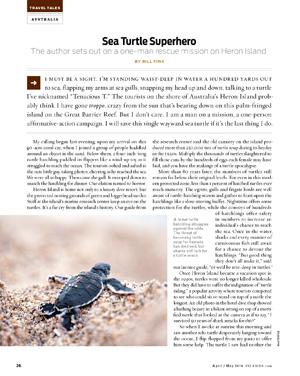Travel Tales: Heron Island, Australia
I must be a sight. I'm standing waist-deep in water a hundred yards out to sea, flapping my arms at sea gulls, snapping my head up and down, talking to a turtle I've nicknamed "Tenacious T." The tourists on the shore of Australia's Heron Island probably think I have gone troppo, crazy from the sun that's bearing down on this palm-fringed island on the Great Barrier Reef. But I don't care. I am a man on a mission, a one-person affirmative-action campaign. I will save this single wayward sea turtle if it's the last thing I do.
My calling began last evening, upon my arrival on this 40-acre coral cay, when I joined a group of people huddled around an object in the sand. Below them, a four-inch-long turtle hatchling paddled its flippers like a wind-up toy as it struggled to reach the ocean. The tourists oohed and aahed at the cute little guy, taking photos, cheering as he reached the sea. We were all so happy. Then came the gull. It swooped down to snatch the hatchling for dinner. Our elation turned to horror.
Heron Island is home not only to a luxury dive resort, but the protected nesting grounds of green and loggerhead turtles. Staff at the island's marine research center keep an eye on the turtles. It's a far cry from the island's history. Our guide from the research center said the old cannery on the island produced more than 250,000 tins of turtle soup during its heyday in the 1920s. Multiply the thousands of turtles slaughtered to fill those cans by the hundreds of eggs each female may have laid, and you have the makings of a turtle apocalypse.
More than 80 years later, the numbers of turtles still remain far below their original levels. For even in this modern protected zone, less than 1 percent of hatched turtles ever reach maturity. The egrets, gulls and frigate birds are well aware of turtle-hatching season and gather to feast upon the hatchlings like a slow-moving buffet. Nighttime offers some protection for the turtles, while the convoys of hundreds of hatchlings offer safety in numbers to increase an individual's chance to reach the sea. Once in the water, sharks and every manner of carnivorous fish still await for a chance to devour the hatchlings. "But good thing they don't all make it," said our laconic guide, "or we'd be arse-deep in turtles."
Once Heron Island became a vacation spot in the 1930s, turtles were no longer killed wholesale. But they did have to suffer the indignation of "turtle riding," a popular activity where tourists competed to see who could sit or stand on top of a turtle the longest. An old photo in the hotel dive shop showed a bathing beauty in a bikini sitting on top of a mortified turtle that looked at the camera as if to say, "I survived 50 years of shark attacks for this?"
So when I awoke at sunrise this morning and saw another solo turtle desperately lunging toward the ocean, I flip-flopped from my patio to offer him some help. The turtle I saw had neither the stealth of darkness nor crowds of hatchlings among which to hide. If I could spot him with a passing glance from my balcony, every gull within the area code probably had the little guy's number.
But now, halfway down the shore, I'm wondering if my interference violates the "survival of the fittest" rule of nature. Given the turtle's solo hatching and late departure time, maybe he just doesn't deserve to survive, maybe he should be gull food. As the wind lightly rustles the palm leaves above me and the soothing sound of small waves laps the shore, I consider my role in this battle in paradise.
Then a gull dives in for the kill. The squawking bird must have sensed that I wasn't paying attention, and he charges before I'm able to shoo it away with basically some frantic hand-waving.
That's when I remember those 250,000 cans of turtle soup.
So with a sense of fair play and a desire to right the old wrongs, I hover above my turtle charge, determined to lead him to the salvation of the sea. I give him a nudge when he becomes stuck in a deep footprint, kick a rock out of his way when he butts his head against it. Regardless of the barrier, the turtle flaps his flippers with a tenacity deserving of a nickname.
When Tenacious T reaches the water, he accelerates dramatically, diving, then poking his head up for air every five strokes or so. As he begins to dive deeper, the gull stops circling, either having lost sight of the turtle or figuring I was going to accompany him all the way to Tahiti.
Soaking up to my waist and moving farther and farther from swimming distance to the shore, I wonder how long my obligation should last. Is it time to release my charge alone to the world? He's already passed his hardest test for survival, making it to the sea. Still, I hate to leave a moment too early and suffer the disappointment of seeing a bird sneak in for a last-second kill.
Finally, when Tenacious T takes a deeper dive, I turn my back and wade toward the shore. I splash the water, telling myself that it will distract the birds, sharks and stingrays. But it's for me, really. I can't bear to hear it if T was taken. And though the odds are against it, I believe that turtle is still out there, swimming the seas, tenacious enough to take advantage of some long odds I improved on a short walk.
